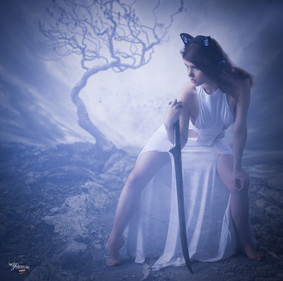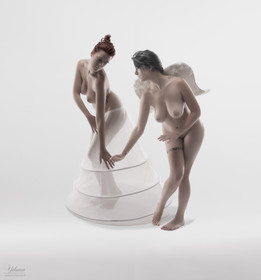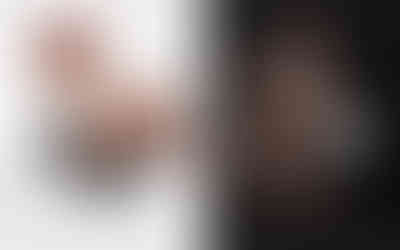Creative process - The evolution of my work
- Yohann Elhadad

- May 29, 2024
- 4 min read
My passion for art began with my childhood admiration for my father, who was a very talented painter. He painted when he was young and stopped to feed his family, promising himself to start again when he was 60. Here's one of his paintings, a reproduction of the Raft of the Medusa, which hangs just behind me as I edit my photos.

Sadly, illness took his life at the age of 60 and a few days, and this landmark event motivated me to practise an art form 'while I'm still alive', something I've been doing with fervour since I was young. After having been a sculptor in my youth, I too took a break because I had children, and like him, I wanted to provide for my family. I've had a number of jobs as an entrepreneur, particularly in business support. In 2012, I bought a camera recommended by a friend, a 5D, which at the time was unaffordable, but my friend told me that day "you won't regret it". And frankly, for 2 years I used it in automatic mode and I found the results very disappointing, the images were quite dark with a dynamic range that I couldn't control at all. Then, during the winter holidays of 2013, I had a professional break during which I wanted to perfect my Photoshop skills, which I'd been using for a long time to do my business presentations. I bought a subscription to Elephorm tutorials and my subscription included access to a photo studio course. This course aroused my curiosity and I bought some entry-level equipment: two flashes, a few softboxes, and I asked a friend to lend a hand with my first experiments. Here are my very first images:
I don't know how to describe how I felt when I realised that you could sculpt with light. The images are still clumsy, with highlights that are far too strong, but the emotion was insane. From there, the passion was born. After that, I started to explore different avenues with multiple collaborations and a desire for complex, if sometimes clumsy, retouching :)
As time went on, I gradually acquired the equipment I needed to make my lighting more professional, working tirelessly to improve every aspect of my work: shooting and, above all, post-production.
Then, what shaped my work was meeting stylists and make-up artists on exciting projects. I really improved and attracted more models and artists to collaborate with and start to stabilise my own style. For each model I was looking for the perfect light, and this trained me to adapt to many different situations and to convey very different moods through light, which gradually became like a language. I also met a friend who became a close friend, Charles-Henri Blachon, who has been passionate about photography for over 20 years and who taught me a lot about light through our friendly days of experimentation.
I began to have really positive feelings about my own work. Even though many people told me that my photos were too 'sweet', too kitsch, and that post-production wasn't real photography, I carried on. I tried again and again to represent the very interior of my imagination.
One day, I had the intuition to buy a course from a photographer I adore, Dimitri, and I followed his 'pictorial photography' tutorials. And I think that's when I found my style. First of all, the orange/turquoise colour scheme that I love so much, but also the perfecting of my integrations after years of effort. When I look back at my work from 10 years ago, it's amazing how much progress I've made. I sometimes think that in 10 years' time, I'll look back on my work today with the same ironic tenderness :)

When you're doing photocomposition, I think the biggest difficulty is finding the right backgrounds. I used to subscribe to Shutterstock and spend hours finding images. But it was never the right direction of light or the right tones, and it took a lot of work to integrate them. When I did manage to find backgrounds, it was one or two at the most. By 'cheating' a bit, I managed to get about ten photos out of each shoot. For me, taking lots of photos is part of my passion, because the shoot tells a real story. Normally, you'd have to start from a background, understand how it's lit and reproduce that in the studio, but it's so tedious that I've tried to do the opposite. Start from the inspiration of the atmosphere of the shoot and look for backgrounds accordingly.
There was a very important turning point in this journey, when I met my partner Gwen. She truly became my muse, inspiring me as much through our many sublime love creations as through the confidence she had in me, I'd say much more than I had in myself. To this day she supports me unconditionally, believing in my professionalism from day one.

All I needed was one thing to really free up my work... And AI has made that absolute dream come true. Create as many backgrounds as I want, with a very literary approach to writing prompts that give me total control over theme, tones and light. It's become the ultimate tool! It was the last stage in my progress towards my current productions and, above all, the number of photos per shoot! Today, I sometimes shoot 50 images per shoot, which is incredible compared to when I started. We'll be talking more about AI in other articles, as it's a fascinating subject from a technical, ethical and societal point of view.
This passion for photography really came to me, initially as a very exciting creative hobby, and as my work has developed I've asked myself a lot of questions to help me become more professional. Wedding photography? Packshot (product photography)? Fashion? All these options imposed constraints that I didn't like at all. I wanted to continue to be free, to continue to explore the artistic dimension of my work rather than 'utilitarian' photography. So I chose the very difficult path of Art, this virtual exhibition site, physical exhibitions, art books and prints. It's a much longer road, but a real choice in terms of creative freedom.
So much for the evolution of my photographic work. I hope this sincere sharing has inspired you.
If you like this kind of article, don't hesitate to like or comment!
See you soon,
Yohann






























































Comments